Struggling to find the right pump for your medical diagnostic device? Incorrect selection can compromise accuracy, reliability, and even patient safety. Let's find your perfect fit.
To choose a micro diaphragm pump for medical diagnostic devices, consider critical parameters like flow rate, pressure/vacuum, material compatibility, control precision, size, and noise, matching them to the specific application's demands for sample handling and fluid transfer.
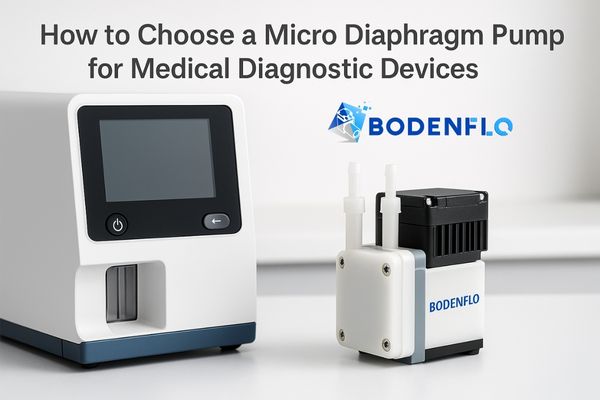
The medical diagnostic field demands the utmost precision and reliability. From analyzing patient samples to preparing reagents, every step needs to be flawless. I've seen how the right components, especially fluidic systems, are fundamental to the performance of these sophisticated instruments. Micro diaphragm pumps have become indispensable here, but selecting the correct one is a detailed process. It's about understanding the nuances of both the pump technology and the diagnostic application. Let's explore what makes these pumps suitable and how to make an informed choice.
Why Are Micro Diaphragm Pumps Used in Medical Diagnostic Devices?
Unsure why these specific pumps are so prevalent in diagnostics? Overlooking their unique benefits could lead to suboptimal device performance. Their features directly address critical medical needs.
Micro diaphragm pumps are used in medical diagnostic devices for their oil-free operation, maintenance-free design, precise flow control, compact size, and low noise, crucial for handling sensitive samples like urine, blood, and other bodily fluids.
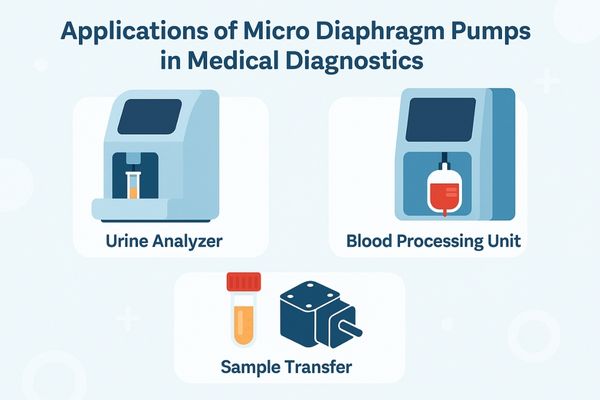
When I talk to engineers developing medical diagnostic equipment, the conversation often turns to the pump. Why micro diaphragm pumps1? It's because their inherent characteristics align perfectly with the stringent requirements of this field. Think about devices like urine analyzers, fecal analyzers, blood processing units, or systems for general body fluid sample transfer.
These pumps perform several vital functions:
- Sample Aspiration2: Gently and accurately drawing precise volumes of patient samples.
- Fluid Transport3: Moving samples, reagents, or cleaning solutions through the instrument's fluidic pathways.
- Quantitative Dilution: Precisely mixing samples with diluents or reagents.
- Cleaning & Waste Liquid Withdrawal: Efficiently flushing channels and removing waste to prevent contamination and ensure readiness for the next test.
The advantages they bring are compelling:
- Oil-Free Operation: Essential to prevent contamination of sensitive biological samples and reagents.
- Maintenance-Free: Critical for devices that need to operate reliably with minimal downtime in clinical settings.
- Precise Flow Control: Allows for accurate metering and consistent test results.
- Compact Size: Enables smaller, more integrated instrument designs.
- Low Noise: Important for patient comfort and a less disruptive lab environment.
These benefits combined make them a go-to choice for designers.
What Parameters Should You Consider Before Selection?
Feeling overwhelmed by pump specifications for your diagnostic device? Choosing based on incomplete data can lead to integration headaches or poor performance. A systematic parameter review is key.
Key parameters for selecting a micro diaphragm pump include flow rate, pressure/vacuum capabilities, control interface, wetted material compatibility with biological fluids, physical size for integration, and operational noise levels.
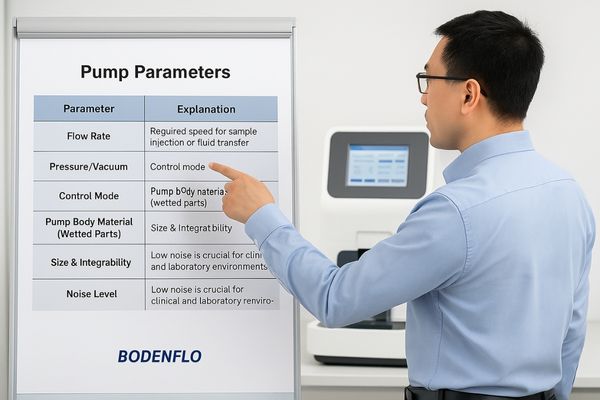
Selecting the right micro diaphragm pump isn't just about picking one off a shelf; it's about a careful matching process. I always advise clients to break down their requirements into specific parameters. This ensures that the chosen pump will perform optimally within their diagnostic device.
Consider these critical aspects:
| Parameter Category | Explanation | Recommended Value Range |
|---|---|---|
| Flow Rate4 | Required speed for sample injection or fluid transfer. | 0.2–2 L/min (application-dependent) |
| Pressure/Vacuum | Impacts efficiency of sample aspiration, dispensing, and cleaning cycles. | ≥ -80 kPa vacuum, ≥ 2 bar pressure |
| Control Mode | Need for adjustable speed/flow (e.g., PWM, FG signal, analog voltage). | PWM adjustable speed is often preferred |
| Pump Body Material (Wetted Parts)5 | Compatibility with blood, urine, reagents, cleaning solutions, buffers. | EPDM / FKM / FFKM / PTFE recommended |
| Size & Integrability | Ability to fit within compact instrument housing. | <100mm body length often targeted |
| Noise Level6 | Low noise is crucial for clinical and laboratory environments. | ≤ 55 dB(A) suitable for analytical labs |
Each of these parameters plays a role. For instance, an insufficient vacuum might lead to incomplete sample aspiration in a urine analyzer. Incorrect material choice could lead to sample contamination or pump degradation when handling aggressive cleaning solutions. We at BODENFLO help engineers navigate these choices to find the perfect balance for their specific diagnostic application.
How to Match Pump Type with Diagnostic Device Application?
Not all diagnostic devices have the same fluidic needs, so how do you pick the right pump features? A mismatch can hinder performance. Tailoring pump characteristics to the application is vital.
Match the pump by considering the specific demands of the application: urine/fecal analyzers need strong suction and stable vacuum, while blood processing may prioritize gentle handling and high chemical resistance.
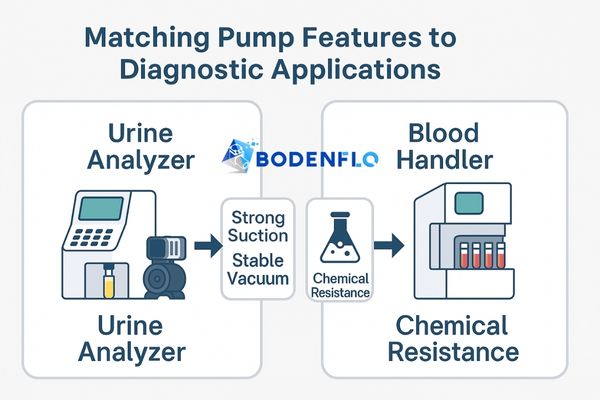
Once you understand the general parameters, the next step I guide clients through is matching specific pump features to the unique demands of their diagnostic device. Different applications within medical diagnostics emphasize different pump strengths.
Here's a general guide based on my experience:
| Application Type | Recommended Pump Features |
|---|---|
| Urine/Fecal Analyzers | Strong suction power (high vacuum)7, low pulsation for stable readings, consistent vacuum performance. |
| Gynecological Secretion Processing | Compatibility with microfluidic systems8, excellent material biocompatibility, precise low flow control. |
| Body Fluid/Blood Sample Processing | Stable flow rate to prevent cell damage9, high chemical resistance for reagents and anticoagulants, minimal shear. |
| Cleaning/Waste Liquid Systems | High vacuum capability for efficient withdrawal, larger flow capacity, robust design tolerant to potential particulates or residues. |
For example, in a system handling delicate blood cells, a pump with a very smooth flow profile and materials that minimize shear stress would be paramount. Conversely, for a waste withdrawal system in a large analyzer, the ability to generate a strong vacuum quickly and handle potentially mixed waste streams would be more critical than ultra-fine flow control. Understanding these nuances is key to optimal device function. At BODENFLO, we often discuss these application-specific details to recommend the most suitable diaphragm and valve configurations.
Brush vs Brushless: Which Motor Type Is Better for Medical Devices?
Confused about whether a brushed or brushless motor is right for your diagnostic pump? The motor choice impacts pump lifespan, reliability, and cost. For demanding medical use, one clearly leads.
For medical diagnostic devices requiring long operational life and continuous use, brushless DC motors are generally better than brushed motors due to their extended lifespan, higher efficiency, and lower maintenance needs.
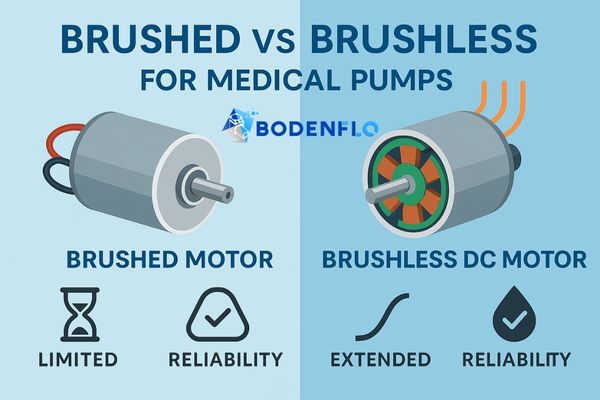
The motor is the heart of the micro diaphragm pump, and its type significantly influences the pump's overall performance, especially in medical applications where reliability is non-negotiable. I'm often asked about the pros and cons of brushed versus brushless DC motors.
-
- Pros: Lower initial cost, simpler drive electronics.
- Cons: Shorter lifespan due to brush wear (typically a few thousand hours), generate electrical noise (EMI) from arcing, require periodic maintenance (brush replacement, though often not feasible in sealed micro pumps).
- Best Suited For: Applications with intermittent operation and where cost is a primary driver, and a shorter device lifespan is acceptable.
-
Brushless DC (BLDC) Motors:
- Pros: Significantly longer lifespan (tens of thousands of hours), higher efficiency, quieter operation, less EMI, no maintenance related to brushes. Can be precisely controlled using PWM for speed adjustment.
- Cons: Higher initial cost, require more complex drive electronics.
- Best Suited For: Applications requiring continuous or frequent operation, long device lifespan, high reliability, and precise speed control – all common in medical diagnostic instruments.
Recommendation: For most medical analyzers that are expected to run automatically for extended periods, or perform many cycles per day, I strongly recommend choosing micro diaphragm pumps11 with brushless DC motors, ideally with PWM control capability. The long-term reliability and reduced maintenance far outweigh the initial cost difference in these critical applications. This is a standard offering for many of our BODENFLO pumps designed for the medical sector.
Why BODENFLO Micro Diaphragm Pumps Are Trusted in Medical OEM Projects?
Looking for a pump supplier that truly understands medical device requirements? Partnering with an inexperienced vendor can lead to delays and compromised quality. BODENFLO offers proven expertise and certified solutions.
BODENFLO micro diaphragm pumps are trusted in medical OEM projects due to our ability to provide customized designs, a wide range of 300+ standard models for rapid selection, and full product line support for CE, RoHS, and our ISO 9001 quality management system.
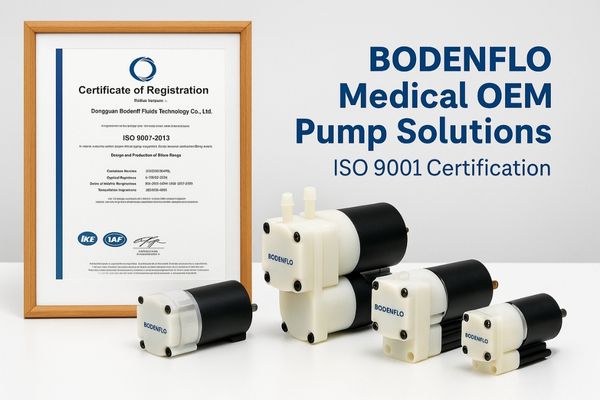
When medical device manufacturers choose a component supplier, trust and proven capability are paramount. At BODENFLO, we've built our reputation by focusing on the specific needs of medical OEM projects. This isn't just about selling a pump; it's about providing a reliable fluidic solution that integrates seamlessly and performs flawlessly.
Here’s why leading medical device companies partner with us:
- Customization Expertise: We understand that off-the-shelf isn't always optimal. Our engineering team excels at customizing designs12 – adjusting dimensions, motor specifications, wetted materials, and performance characteristics to precisely match the unique requirements of your diagnostic device.
- Extensive Standard Range: With over 300+ standard parameter models, we can often provide a quick and effective solution, accelerating your development timeline. This diverse portfolio covers a wide array of flow, pressure, and vacuum needs.
- Commitment to Quality & Compliance: The medical field demands adherence to stringent standards. Our entire product line supports CE and RoHS compliance, and we operate under an ISO 9001 certified quality management system13. This demonstrates our commitment to designing and manufacturing products with consistent quality.
- Proven Track Record: Our micro diaphragm pumps have been successfully integrated and validated in numerous medical devices, including urine analyzers, gynecological sample processing units, and other diagnostic systems. This real-world success provides confidence to our OEM partners.
We aim to be more than a supplier; we aim to be an extension of your design team.
FAQs When Selecting a Pump for Medical Diagnostic Equipment?
Still have questions about choosing the right pump for your medical device? Unanswered queries can stall development. We address common concerns to help you move forward confidently.
Common FAQs involve biocompatibility, pulsation reduction, and clinical safety. BODENFLO addresses these with material choices like PTFE/FKM, dual-head designs, and inherently oil-free, low-noise operation.

I've found that even after detailed discussions, engineers often have a few more specific questions when selecting pumps for sensitive medical diagnostic equipment. Here are some of ahe most frequent ones, along with how we address them at BODENFLO:
-
Q: Can the pump handle biologically active fluids without denaturing them or leaching contaminants?
- A: Yes, absolutely. This is a core consideration for us. BODENFLO offers pumps with wetted parts made from highly inert and biocompatible materials like PTFE, FKM, and select grades of EPDM. These materials minimize interaction with biological samples and reagents, preserving their integrity.
-
Q: How do I reduce pulsation in the flow if my assay is very sensitive to it?
- A: Pulsation can be a concern with diaphragm pumps. To mitigate this, we recommend several approaches: choosing our double-head diaphragm pump designs (which inherently reduce pulsation), optimizing tubing configurations, or in some cases, incorporating a small, appropriately sized damping chamber downstream of the pump.
-
Q: Is the pump safe for use in clinical or patient-proximate environments?
- A: Safety is paramount. All BODENFLO micro diaphragm pump models are oil-free in their operation, eliminating the risk of oil aerosol contamination. They are also designed for low noise operation to ensure a comfortable environment, and being maintenance-free (especially our brushless models) reduces the need for service interventions in sensitive areas.
These are just a few examples, and we're always ready to discuss any specific concerns related to your application.
Conclusion
Choosing the right micro diaphragm pump ensures diagnostic devices operate with precision, efficiency, and reliability. BODENFLO offers proven solutions tailored for diverse medical applications.
📩 Contact us for datasheets, test samples, or OEM customization plans:
📧 info@bodenpump.com
🌐 bodenpump.com
-
Explore how micro diaphragm pumps enhance accuracy and reliability in medical diagnostics, ensuring optimal performance in critical applications. ↩
-
Learn about the importance of sample aspiration in diagnostics and how it ensures precise volume measurement for accurate results. ↩
-
Discover the significance of fluid transport in diagnostics, ensuring efficient movement of samples and reagents for reliable testing. ↩
-
Understanding the ideal flow rate can enhance efficiency in fluid transfer processes, crucial for accurate results in labs. ↩
-
Choosing the right materials for pump wetted parts ensures compatibility with various fluids, enhancing safety and performance. ↩
-
Exploring acceptable noise levels helps maintain a conducive working environment in labs, ensuring comfort and focus during experiments. ↩
-
Understanding the importance of strong suction power can enhance your knowledge of urine analyzers' efficiency and reliability. ↩
-
Exploring this topic can reveal how microfluidic compatibility enhances precision in medical applications. ↩
-
Learning about stable flow rates can help you appreciate their role in preserving sample integrity during analysis. ↩
-
Understanding the drawbacks of brushed motors can help you choose the right pump for your needs, especially in critical applications. ↩
-
Discover top-rated micro diaphragm pumps tailored for medical use, ensuring reliability and performance in your applications. ↩
-
Explore how customizing designs can enhance the functionality and efficiency of medical devices, ensuring they meet specific needs. ↩
-
Discover the importance of ISO 9001 certification in ensuring quality and compliance in medical device production. ↩


